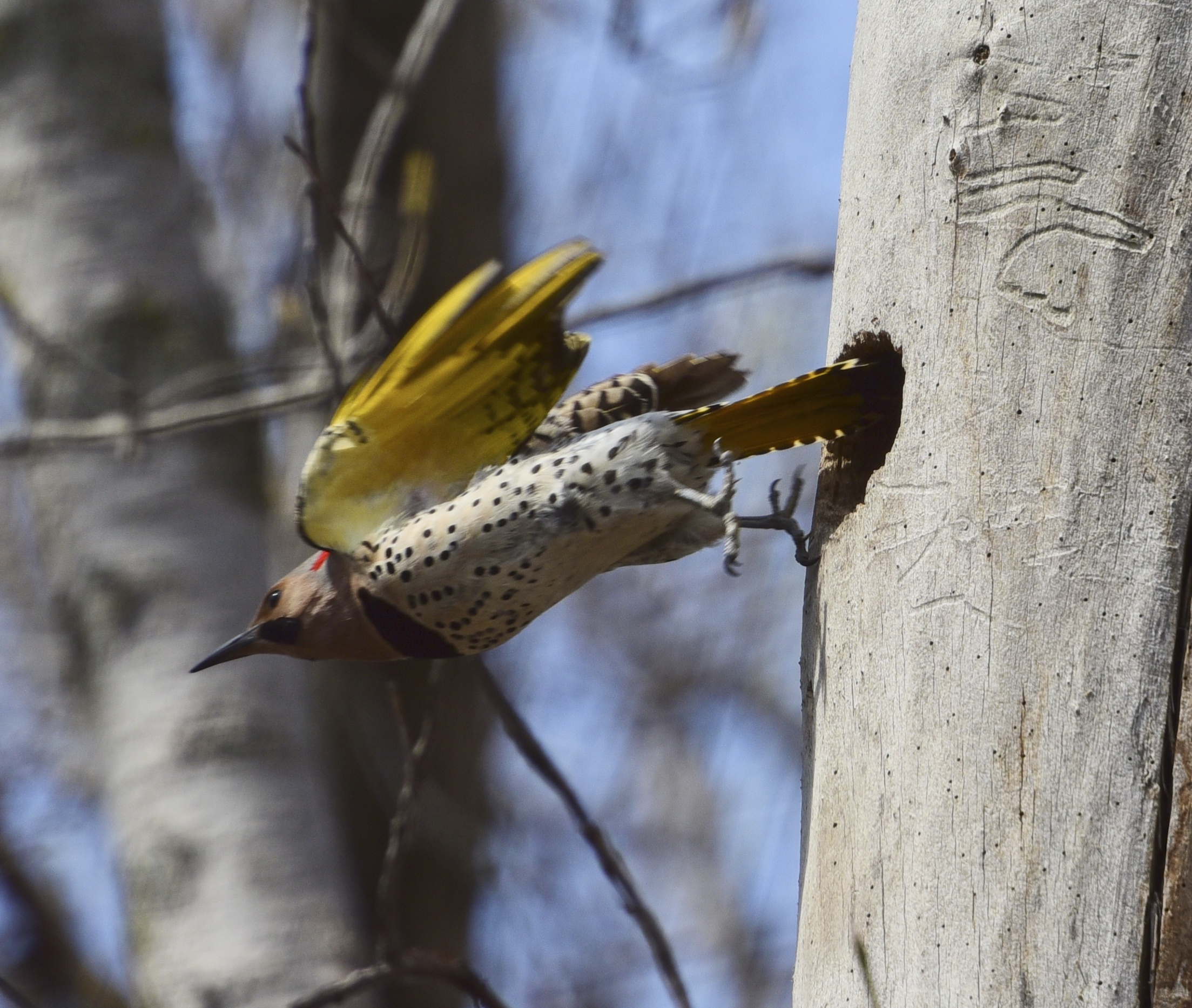There’s a lot of drumming going on in the trees on Owl Acres. Woodpeckers are staking out their territory and calling to potential mates. One of the drummers is a northern flicker (Colaptes auratus). Unlike Woody Woodpecker and all his cousins, the northern flicker is brown, not black. He does have a profusion of black dots, bars and crescents adorning the brown wings and back. He also has a white rump patch that flashes when he flies. His claim to fame, though, is the brightly colored shafts of the feathers on the undersides of his wings and tail. If his family is from the East, these feathers will likely be bright yellow. If his family is from the West, they will likely be red. And if he is of mixed parentage, as happens where the ranges of the red and yellow races overlap, they will have some traits from each. Yellow-shafted birds have tan faces, and gray crowns, with a red crescent on the nape of their necks. Males will have a black mustache stripe. This is most likely the coloring of my morning drummer. If he’s from the red race, his face will be gray with a brown crown and a red mustache line.
Both of these races are native to North America and range from Canada and Alaska to as far south as Nicaragua. My percussionist has spent the winter somewhere in the south, possibly Texas or even into Mexico. I first noticed him the second week of April, and he’s been a busy presence ever since. He’s drumming on hollow tree trunks and anything else he can find with a loud resonance. His goal here is not to find insects in the tree but to announce his presence and stake out his territory.
The northern flicker is a good-sized bird, larger than a robin. He weighs between four and five-and-a half ounces, (compared with 3 ounces for a robin, and about half an ounce for a sparrow). His wing span is up to 20 inches, and he measures 11 to 12 inches from his slim, rounded head to his long, flared tail. Unlike other woodpeckers that drill into trees to roust insects, the northern flicker prefers to find food on the ground. He is particularly fond of ants. To find them, he will hammer his beak into the dirt and send them scurrying. He has a very long tongue that he can extend up to two inches beyond the end of his slightly curved beak. His tongue is coated with sticky saliva which helps him snag the ants. Along with the ants, the flicker will eat grubs, beetles and other insects and their larvae as well as fruits and seeds in season.
The flicker’s beak isn’t as strong as other woodpeckers’, so they prefer to excavate a hole for their nest in very soft or rotting wood in dead trees or telephone poles. And if one is handy, the pair will work together to enlarge an existing cavity to suit their needs.
The male flicker takes full responsibility for his family. He helps prepare the nest, and after his mate lays a clutch of six to eight shiny white eggs, he will incubate them all night and half the day, letting her take over the incubation for the remaining half day. Incubation takes about 11 to 16 days. After that he helps feed the nestlings for another 28 days before they fledge. After they leave the nest, the parents keep track of them and teach them how to find their own food. In the fall they will all fly east and then south, joining flocks that migrate by day to winter where it’s warm and food is plentiful.
Parasites are an ongoing challenge for every living thing. This naturally includes birds. Northern flickers and other birds have many strategies for combating them. One strategy is called anting. The bird will lie on the ground on or near an anthill. The goal this time is not to eat the ants, but rather to let the ants crawl all over them. It makes me itch just thinking about it! The benefit to this odd picnic is that the ants leave trails of formic acid on the birds’ feathers when they crawl on them. The formic acid helps discourage other parasites such as lice. So, after the ant bath, do they eat their little bathers?
Photo by Mykola Swarnyk

1 comment